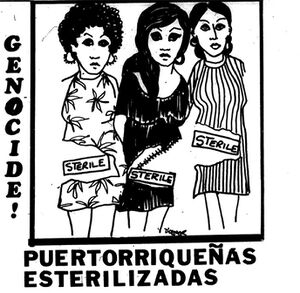Difference between revisions of "Operation Bootstrap"
(population reduction operation) |
m (add image) |
||
| Line 1: | Line 1: | ||
{{event | {{event | ||
|description=Between 1930 and 1970, around one third of all women in the US territory of [[Puerto Rico]] were sterilized | |description=Between 1930 and 1970, around one third of all women in the US territory of [[Puerto Rico]] were sterilized | ||
| − | |image= | + | |image= PR women sterilized.jpg |
| + | |image_caption=Poster against the campaign | ||
|type= | |type= | ||
|ON_constitutes=economic development | |ON_constitutes=economic development | ||
Latest revision as of 13:16, 29 December 2023
 Poster against the campaign | |
| Date | 1930 - 1970 |
|---|---|
| Location | Puerto Rico, USA |
| Perpetrators | US government, public health officials, eugenics movement |
| Description | Between 1930 and 1970, around one third of all women in the US territory of Puerto Rico were sterilized |
Project Bootstrap was the name for a operation to transform the US territory of Puerto Rico. As part of the program, between 1930 and 1970, around one third of all women in Puerto Rico were sterilized to address concerns of "surplus population"[1].
Official narrative
Operation Bootstrap (Spanish: Operación Manos a la Obra) is the name given to a series of projects which transformed the economy of Puerto Rico into an industrial and developed one.[2]
Mass sterilization
In 1898, the United States government acquired Puerto Rico after the Spanish-American War. For the next decades, the government of the island was appointed by the US government.[1]
In the 1920, he US government drew up plans to develop the island. In 1947, US Congress passed the Industrial Incentives Act, which became a part of "Operation Bootstrap," the name given to a number of projects that aimed to industrialize Puerto Rico's agrarian economy.[1]
During these programs, the US federal government came up with a two-pronged approach to reduce overpopulation". In the short term, they encouraged Puerto Ricans to migrate to the mainland United States and surrounding islands in the Caribbean. In the long term, they encouraged sterilization and birth control, which was supported by the strong eugenics movement in the US, the local appointed government and public health officials.[1]
In 1937, contraception and sterilization was made legal in Catholic Puerto Rico. When signing the bill, Acting Governor Rafael Menendez Ramos made a statement in support of the legalization of sterilization, citing the problem of "surplus population," writing that "the inevitable consequence is increasing unemployment, growing poverty and mounting misery."[1]
By 1969, approximately 35% of all Puerto Rican women of child-bearing age had been sterilized.[3]
Opposition
Puerto Rico's birth control was opposed by the Catholic Church and Puerto Rican nationalists. The Catholic Church took their position on birth control based on religious grounds. The nationalists considered that the US as a colonial power had plans of physical and cultural genocide of Puerto Rico.[1]